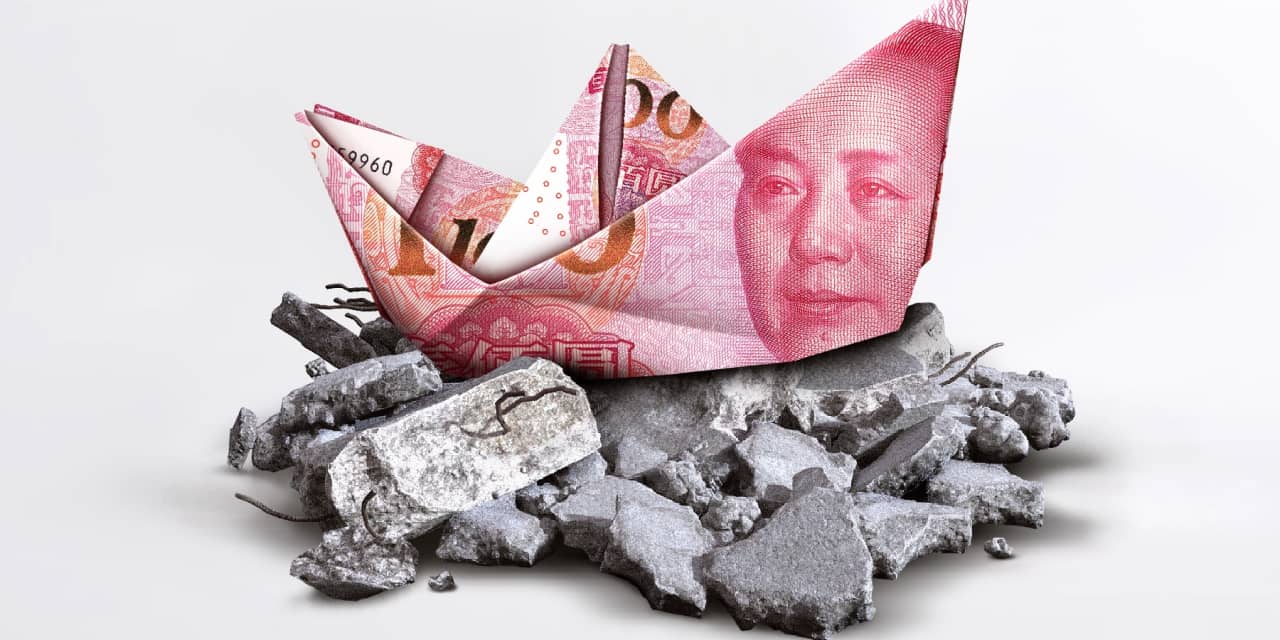About the author: Alicia García Herrero is chief economist for Asia Pacific at Natixis and senior research fellow at Bruegel.
The Chinese economy was supposed to be a global star in 2023. The U.S. and the European Union were expected to bear high interest rates to tame inflation. China, meanwhile, should have enjoyed huge tailwinds after ending its zero-Covid policies. That was expected to push China’s currency toward appreciation, after having weakened substantially since the Covid-related lockdowns started in March 2022.
The reality is different. The West isn’t in recession, while the Chinese economy has grown much less than expected, making it harder to reach what was thought to be a rather underwhelming growth target of 5% for 2023. Against that backdrop, the yuan, or renminbi, has depreciated more than 8% against the dollar since its peak in January, after the euphoria from the reopening from zero-Covid policies.
Worries about the Chinese economy have mushroomed this year, from the demise of the real estate sector to the financial health of local governments. The U.S. has advanced its efforts at technological containment and has recruited the Netherlands and Japan to its chip ban. Those efforts will at least temporarily affect China’s ability to move up the tech ladder.
External demand has been China’s main growth engine since Covid started in 2020, but it has been waning since the beginning of the summer. Chinese exports have fallen for three months in a row, by as much as 14.5% in July. This dismal performance contrasts with the competitiveness gains that China has accumulated since the beginning of the year, due both to currency depreciation and to the deflation of export prices, which have fallen a cumulative 3.5% since the beginning of 2023. China would probably have depleted its large trade surplus without the support of the yuan and falling export prices.
The yuan’s depreciation has multiple drivers. Below-expectations growth is one. Another is that in 2023, the People’s Bank of China has been cutting rates while the U.S. Federal Reserve has continued to raise them. Before the pandemic, China’s interest rate was 200 basis points higher than the U.S. That has now flipped, with the differential over 160 basis points in the U.S. favor. (A basis point is a hundredth of a percentage point). The result has been large fixed-income capital outflows from China. Foreign investors in Chinese equities have been more patient, as they were expecting a fiscal stimulus after announcements made by Chinese policy makers in July. By the end of August, though, with no sign of such stimulus, equity investors started to pack up and leave. That has led to a further depreciation of the yuan.
Outright capital flight—that is, unrecorded outflows from China’s residents—is also on the rise. That can be seen from the fact that China’s large trade surplus hasn’t yet resulted in any increase in China’s foreign reserves. In other words, the trade surplus is being leaked out of China in ways that are hard to track. Geopolitical risk involving Taiwan and Russia has also put pressure on the future of the yuan.
Where is the currency headed? On the negative side, the Chinese economy isn’t expected to improve its performance anytime soon. The PBOC will be forced to continue to support the economy by cutting interest rates, more so since the Chinese leadership doesn’t seem ready to introduce a large fiscal stimulus. On the positive side, the Fed should be close to peaking—with one more hike, if at all—and may begin to cut rates next year. All in all, the interest-rate differential between the U.S. and China is likely to stay steady. The PBOC seems to be comfortable with the current, rather weak level of the yuan but isn’t eager to see a further depreciation, judging by the support it has engineered on several occasions through foreign exchange interventions by Chinese commercial banks. On Monday, the PBOC issued a warning against betting on depreciation.
However, there is no appetite for a stronger currency. Rightly so. Chinese exports are falling for the first time in decades just as China is desperately looking for engines of growth. Second, keeping a trade surplus has never been so important to China. It needs to avoid the loss of foreign reserves due to the lack of confidence in the economy and the related capital outflows. For these reasons, one would expect the PBOC to manage a slow but steady depreciation of the yuan when circumstances warrant it or, in other words, when such depreciation isn’t seen as weakness pushing capital flight further.
The dollar is strong for now, but the Fed should facilitate the PBOC’s mission when it starts cutting rates next year. The yuan could well follow the dollar in its depreciation path against other currencies as the Fed normalizes its monetary policy. That is, the dollar may come to the yuan’s rescue through its future weakness.
What isn’t clear, however, is how the rest of the world will bear not only a weak dollar but also a weaker yuan. That may be the next complication to work through.
Guest commentaries like this one are written by authors outside the Barron’s and MarketWatch newsroom. They reflect the perspective and opinions of the authors. Submit commentary proposals and other feedback to ideas@barrons.com.
Read the full article here











Leave a Reply